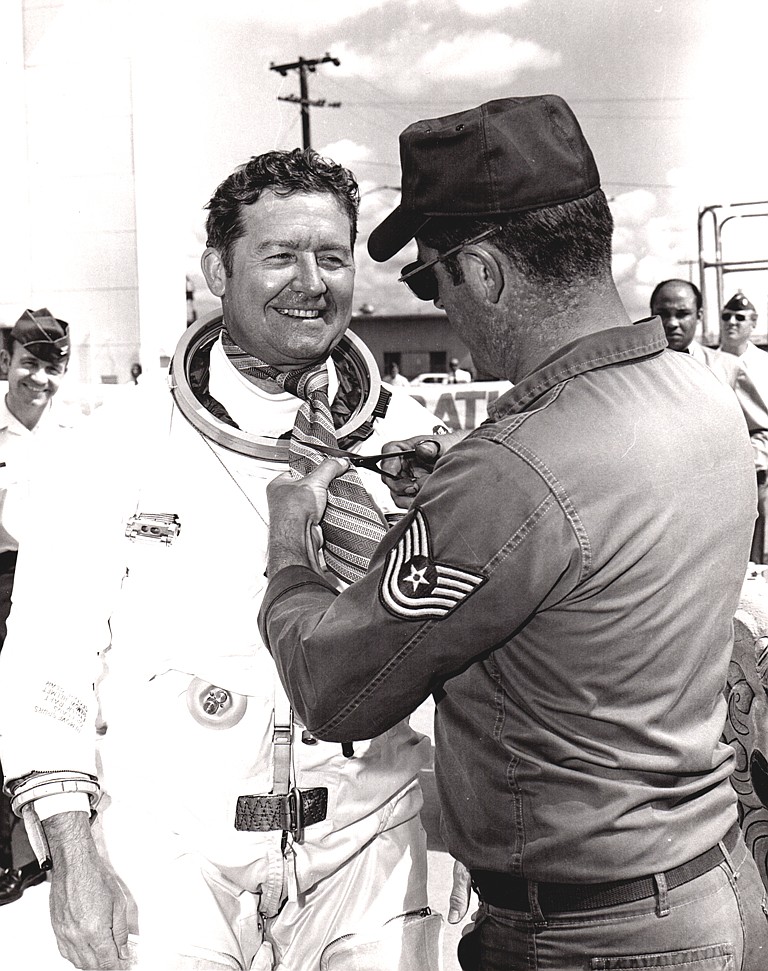Editor's note: This article is the third in a five-part series highlighting the life and military career of Maj. Gen. Don D. Pittman.
Lockheed's SR-71 Blackbird - a smoothly contoured, supersonic aircraft - for decades captured the imagination of youth while also frustrating many foreign governments seeking to conceal secrets that might possibly be gathered through aerial reconnaissance. This aircraft appeared the material of high-flying dreams and out of the reach of the average citizen, yet one local veteran had many intimate experiences with this fascinating machine, witnessing its service on the frontline of the Cold War.
Born in 1925 in Jefferson City, the late Don D. Pittman went on to graduate from St. Peter's High School in 1943. Months later, he entered active military service and rose to the rank of major general in the U.S. Air Force, eventually retiring after more than three decades in uniform.
Pittman's military career was peppered with many interesting assignments during which he served as "a command pilot with more than 11,000 flying hours in 42 types of aircraft," noted his Air Force biography. However, one of the most interesting experiences was a milestone reached while strapped in the cockpit of an SR-71 Blackbird.
The development of the Blackbird came under the guidance of a group named "Skunk Works," described by the Los Angeles Times on Nov. 24, 1996, as "Lockheed Martin's elite, rapid-prototyping organization" went on to deliver "an historic breakthrough - from the revolutionary U2 reconnaissance aircraft to the incomparable SR-71 Blackbird to the F117A Stealth Fighter."
According to an article on the website of Lockheed Martin, the development of the legendary aircraft came from a request originating in Washington, D.C., asking that the company "build the impossible - an aircraft that can't be shot down."
Designs eventually evolved into the SR-71, an aircraft more than 100 feet in length and possessing a small radar profile. Making its first flight Dec. 22, 1964, NASA explained the "Blackbirds were designed to cruise at Mach 3.2, just over three times the speed of sound or more than 2,200 miles per hour and at altitudes up to 85,000 feet," making it ideal for Cold War reconnaissance missions.
The SR-71 mission and its support elements were formed at Beale Air Force Base (AFB) in January 1965 and designated the 4200th Strategic Reconnaissance Wing (SRW), with the first aircraft being delivered the following year. The 4200th SRW then transitioned to the 9th SRW, which fell under the command of the 14th Air Division. In 1968, the SR-71 was declared operationally ready.
Already possessing flight service that included the Berlin Airlift and 277 combat missions flown in Vietnam, Pittman acquired an intimate experience with the SR-71 Blackbird in May 1973, shortly after he assumed command of the 14th Air Division at Beale AFB, California.
"Under (Pittman's) command were reconnaissance, bombardment, airborne command and control and refueling organizations equipped with SR-71, B-52, EC-135, RC-135, and KC-135 aircraft," noted Pittman's official biography available on the Air Force website.
The Wheatland News (Wheatland, California) reported Oct. 12, 1973, that Pittman reached a "unique milestone" when he "logged both his first hour in the SR-71 and his 10,000th hour for all aircraft" in a flight that occurred Sept. 20, 1973.
"After undergoing extensive physical examinations and training, the general was airborne flying under the instruction of Maj. Randy Hertzog, an instructor pilot assigned to the 1st Strategic Reconnaissance Squadron," the newspaper further reported.
As part of a tradition developed among those completing the first flight in an SR-71, Pittman wore a necktie under his space suit (the outfit necessary for the high altitudes the aircraft could achieve). Upon return from the flight, Gen. Pittman then submitted to the ceremonious cutting of his necktie to denote completion of his first successful mission in the SR-71.
In the years succeeding his Blackbird flight, Pittman would go on to complete several assignments including command of the 314th Air Division at Osan Air Base in the Republic of Korea in addition to serving as commander of the 24th NORAD Region. On Oct. 1, 1978, he retired at the rank of major general.
His time in command of the 14th Air Division and the SR-71 Blackbird operations at Beale AFB may constitute little more than a page in the lengthy book of his career; however, even in retirement, Pittman demonstrated a vested interest in the disposition of aircraft in the Air Force inventory.
"The United States officially retired its original stealth jet that for 25 years rocketed at 2,100 mph to the edge of space as it spied above reach of attacks on global hot spots," reported the San Bernardino County Sun on Jan. 27, 1990.
In a special ceremony Jan. 26, 1990, at which Pittman was an honorary guest, a final salute was paid to the legendary aircraft. Though retired, the SR-71 would live on in the memories of the pilots and those who supported its secretive missions and quickly become a much-desired museum piece still able to strike awe in the hearts of aviation enthusiasts.
"It is with sorrow that we end this chapter in aviation history," wrote an unknown author in a bulletin provide to Pittman and other attendees at the SR-71 retirement ceremony. "The SR-71 performed 25 years of dedicated service to the nation's reconnaissance effort and will always be a source of national pride and international recognition."
Jeremy P. mick writes on behalf of the Silver Star Families of America.

